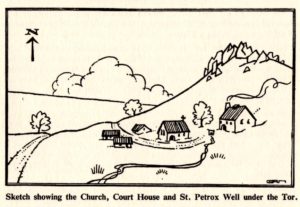The English Riviera website comments that Torquay’s, “famous seven hills provide the backdrop to a waterfront scene that matches anything you’ll find on the French Riviera”; and Devon Live claims that, “Everybody knows that Torquay, like Rome, is built on seven hills.”
The idea of seven hills has been eagerly adopted locally and we have the Lodge of the Seven Hills Masonic Temple, founded in 1949, and the Seven Hills Amateur Boxing Club.
So, are there seven hills, and was Torquay built on them?
Sadly, this is another one of those Edwardian myths.
First of all, there isn’t a definitive list, though the following have been suggested: Westhill, Barton Hill, Daccombe Hill, Sherwell Hill, Sheddon Hill, Stentiford Hill & Braddon Hill.
Some of these candidates are quite unlikely. Daccombe is a very long way from the original rural communities of Torre and the Strand; while Shedden Hill was only named in the 1850s.
We’re not even sure of the actual number of hills. AJ Jukes-Browne in 1907 in ‘The Hills and Valleys of Torquay’ identified eight:
“It was the boast of ancient Rome that the city stood on seven hills, but in this respect Torquay can claim still greater distinction, for our town spreads over no fewer than eight hills, some of which are higher than those of Rome. On the southern front, presenting bold precipices to the bay, are three fine hills: Waldon Hill, rising above the well known ‘Rock Walk’ to a height of 200 feet above the sea; Vane Hill and its prolongation into Daddy Hole Plain, which are both more than 200 feet high; lastly the wooded and winding slopes of Lincombe Hill with its central ridge which reaches an elevation of 400 feet above the sea. North of the last is the long ridge of Warberry Hill, the summit of which is the crowning height of Torquay (448 feet), and from it descend the western spurs which are known as the Braddons Hill and Stentiford’s Hill. Beyond these, to the North-West, are the smaller eminences of Castle Hill and Torre Hill. These are the eight central hills.”
‘Torquay’ certainly wasn’t originally built on seven hills as there wasn’t a Torquay.
The manor was recorded in 1086 as Torra, the name deriving from the Old English Torr, a rocky hill. It’s also generally accepted that the ‘tor’ in Torbay refers to the distant hills of Dartmoor. Torrrebay is not recorded before 1401 and ‘bay’ is a Norman word. The suggestion is that the Bay was named by seafarers to differentiate the hills from those of Dorset.
Torquay is now built on hills but is a relatively modern town. The first mention of the name ‘Torquay’ seems to come from the execution of Catholic martyr Cuthbert Mayne in 1577 when instructions were given for a “quarter” of his body to be put on a pole at an obscure place called “Torquay”.
So why seven hills?
It was largely due to prestige and the Victorian and Edwardian enthusiasm for all things classical. The title City of Seven Hills usually refers to Rome. But, since Rome was founded many cities have claimed to be built on seven hills, including Bristol, Brussels, Bath, Madrid, Constantinople, Washington DC, Cincinnati, San Francisco Seattle, Mumbai, Barcelona, Liverpool, Brisbane etc.
What usually happened is that a defensive site begins on a hill and then, as a town spreads, it takes in other hills – Anglo-Saxon ‘Torquay’ began underneath a craggy tor and then spread over the next thousand years to encompass other hills. We just stopped counting when we got to a nice number. And we didn’t even have a good definition of what a hill is. Isn’t Shedden Hill just the lower slope of Waldon Hill?
It’s also notable that the number seven has special significance in the Christian tradition: the seven days of Creation; God rested on and sanctified the seventh day (Sabbath); Noah is commanded to bring seven pairs of every clean animal onto the ark; seven days of the feast of Passover. As a new town with a high degree of self importance, an imperial mission, and an Anglican elite, seven hills just seemed appropriate.
And so while we can’t really claim to be built on seven hills, there is a link to another place and prophesy.
During the 1880s a mysterious group calling itself ‘The Order of the Temple’ occupied ‘Cloudlands’, a house in Torquay’s Chelston. Their leader was the Spiritualist Countess Marie Borel. The Countess believed that her adopted son, Prince Baptiste St John Borel, also known as ‘Mr Northlew’, had special powers. She also understood herself to be the “woman clothed with the sun” who was to “bear the child to rule the world with a rod of iron”.
This is a reference to the ‘Woman of the Apocalypse’, a figure from the Bible’s Book of Revelation which describes in lurid detail the end of the world. It was written in about AD 95. In the Bible the woman gives birth to a male child who is threatened by Satan. When the child is taken to heaven, the woman flees into the wilderness leading to a ‘War in Heaven’ in which God’s angels eventually triumph. Satan takes his revenge on the woman and, in the form of a dragon, initiates war on “the remnant of her seed”, identified as the righteous followers of Christ.
Revelation says, “I saw a woman sit upon a scarlet coloured beast, full of names of blasphemy, having seven heads. And the woman was arrayed in purple and scarlet colour, and decked with gold and precious stones and pearls, having a golden cup in her hand full of abominations and filthiness of her fornication. The seven heads are seven hills, on which the woman sitteth.”
We don’t know whether the Countess was attracted to Torquay because of the seven hills myth and after a few months of activity we hear nothing more of her or the Prince. On the other hand, the Bible does say the end of the world would begin in a place with seven hills…
 You can join us on our social media pages, follow us on Facebook or Twitter and keep up to date with whats going on in South Devon. Got a news story, blog or press release that you’d like to share or want to advertise with us? Contact us
You can join us on our social media pages, follow us on Facebook or Twitter and keep up to date with whats going on in South Devon. Got a news story, blog or press release that you’d like to share or want to advertise with us? Contact us

































